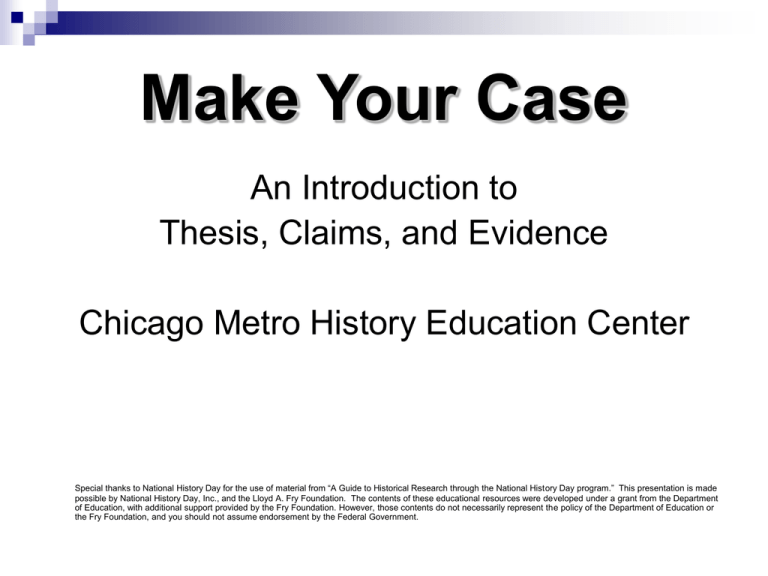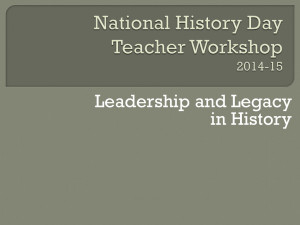`Make Your Case` Thesis Powerpoint
advertisement

Make Your Case An Introduction to Thesis, Claims, and Evidence Chicago Metro History Education Center Special thanks to National History Day for the use of material from “A Guide to Historical Research through the National History Day program.” This presentation is made possible by National History Day, Inc., and the Lloyd A. Fry Foundation. The contents of these educational resources were developed under a grant from the Department of Education, with additional support provided by the Fry Foundation. However, those contents do not necessarily represent the policy of the Department of Education or the Fry Foundation, and you should not assume endorsement by the Federal Government. Make Your Case What does a History Fair student have in common with an attorney in a courtroom? Your thesis statement tells the reader or viewer in 1-2 sentences what your project will attempt to prove or analyze. A good thesis statement: • Takes a stand by making a point which will be backed up by evidence • Has a narrow and specific focus • Expresses one main idea • Tells the viewer why the subject is historically significant, and often suggests change over time • Is presented as a statement, not a topic or question • Is historical, not a statement about current events If you are using the National History Day theme “Debate and Diplomacy in History: Successes, Failures, Consequences,” you should integrate the theme into the analysis presented in your thesis. You can use the words of the theme explicitly or you can express the relationship to the theme by using different words that convey the same idea. Let’s help this student from Milwaukee strengthen their thesis statement.* What’s wrong with this thesis statement? Immigration to Milwaukee *Taken from A Guide to Historical Research through the National History Day Program How did Lizzie Black Kander make a difference to Milwaukee’s Jewish immigrant community? Lizzie Black Kander and Jewish Immigration to Milwaukee from 1880-1920. Lizzie Black Kander used her cooking classes and The Settlement Cookbook to teach Milwaukee’s Jewish immigrants about American culture. Through her cooking classes and The Settlement Cookbook, Lizzie Black Kander introduced Milwaukee’s Jewish immigrants to American culture, which helped them assimilate and learn how to avoid ethnic discrimination. Judge your own draft thesis statement! Does it… • Take a stand? • Is the topic narrow? • Is the thesis clear and specific? • Can the assertion be backed up by evidence? • Does it express one main idea? • Does it tell the viewer why the subject is historically significant? Does it answer the “So what?” question or show change over time? • Is it presented as a statement, not a topic or question? • Is it historical? If you were creating the Lizzie Black Kander project, what types of primary and secondary sources would you seek out in order to develop and support your thesis? What’s your evidence? PRIMARY Photographs Map Census Letters Interviews or Oral Histories, Memoirs Newspapers Cookbooks “Rights” organizations or protective associations SECONDARY Encyclopedias of… Books and articles about settlements, immigration, Milwaukee, Jewish community, food and cooking, assimilation Biography Interview with expert Check these theses 1) After the 1919 riot the means of enforcing segregation became more accepted, more formal, often more violent, and completely legal. 2) Pesticides kill thousands of farmworkers and must be stopped. 3) How did The Jungle make an impact on the foods we eat? 4) The Juvenile Court system was established to remove children from the adult criminal justice system and help them reform, but over the years it became a source of punishment and imprisonment. 5) Richard J. Daley died in 1976.











